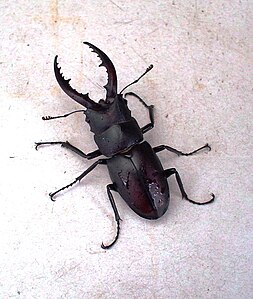大顎
 ウィキペディアから無料の百科事典
ウィキペディアから無料の百科事典

大顎(おおあご、だいがく[1]、英:mandible)とは、大顎類の節足動物に特有の1対の付属肢(関節肢)であり、口器を構成する器官の1つである。大腮(たいさい)とも呼ばれる[1]。
概要[編集]
| 体節: | 先節 | 1 | 2 | 3 | 4 | 5 |
|---|---|---|---|---|---|---|
| 付属肢: | 上唇 | 第1触角 | 第2触角/(退化) | 大顎 | 第1小顎 | 第2小顎/下唇 |
大顎類の節足動物、いわゆる多足類・甲殻類・六脚類などの頭部は、基本として口器に特化した3対の付属肢(関節肢)をもつ。そのうち最初の1対が大顎である。それに対して残り2対の顎は小顎(こあご、しょうがく、英:maxilla)と呼ばれるが、これらは必ずしも大顎より小さいとは限らない。大顎は発生学・体節制的に第3体節由来で、口と触角の直後に配置される[2][3]。
大顎の本体部分(gnathal element)は付属肢最初の肢節、すなわち原節(protopod, basipod)のみから構成されるため、途中は原則として肢節的な関節はない(多足類のみ二次的な関節構造をもつ[4])。多くの甲殻類は、大顎の外側に大顎髭(mandibular palp)という直後の肢節に当たる部分が残されるが、多足類、六脚類、および一部の甲殻類(鰓脚類・カシラエビ類・ムカデエビ類、軟甲類の一部など)の場合、この大顎髭は少なくとも成体で完全に退化消失している[5]。
多様性[編集]

A:バッタ
B:ミツバチ
C:チョウ(大顎は退化消失)
D:カ
通常、大顎類の3対の顎の中で大顎は特に頑丈な方で、内側に歯が生えて、餌を把握・切断・粉砕する役割を担う器官である。しかしそれに当てはまらない例外もあり、昆虫で特に多く見られる。液体状の餌を摂るのに特化した昆虫、例えば半翅類(カメムシ・セミなど)やカの大顎は、他の口器と共に細長く変形し、口針の一部を構成する[6][7]。一部の昆虫、例えば多くのクワガタムシのオスは、摂食の代わりに闘争用の武器に変化した大顎をもつ[8]。大顎が退化的になったものもあり、例えばコバネガ以外の鱗翅類(ガとチョウ)の成体は大顎が退化消失するほどである[9]。
大顎と誤解される付属肢[編集]

クモの鋏角(上顎)やムカデの顎肢は顎のような形をした口器であるため、しばしば誤って "大顎" と紹介されているが、いずれも顎ですらなく、大顎とは別起源(大顎は第3体節由来に対して、鋏角は第1体節、顎肢は第6体節)の付属肢である[2]。クモを含めて鋏角類にそもそも顎はなく、ムカデの実際の大顎は常に平板状の第1小顎に覆われて目立たない[10]。
脚注[編集]
- ^ a b 日本国語大辞典, デジタル大辞泉,大辞林 第三版,精選版. “大顎とは”. コトバンク. 2020年10月18日閲覧。
- ^ a b Hughes, Cynthia L.; Kaufman, Thomas C. (2002-03-01). “Exploring the myriapod body plan: expression patterns of the ten Hox genes in a centipede” (英語). Development 129 (5): 1225–1238. ISSN 0950-1991. PMID 11874918.
- ^ Ortega-Hernández, Javier; Janssen, Ralf; Budd, Graham E. (2017-05-01). “Origin and evolution of the panarthropod head – A palaeobiological and developmental perspective” (英語). Arthropod Structure & Development 46 (3): 354–379. doi:10.1016/j.asd.2016.10.011. ISSN 1467-8039.
- ^ Koch, Markus (2003-08-01). “Monophyly of the Myriapoda? Reliability of current arguments”. African Invertebrates 44 (1): 137–153. doi:10.10520/EJC84509.
- ^ Schwentner, Martin; Combosch, David J.; Pakes Nelson, Joey; Giribet, Gonzalo (2017-06). “A Phylogenomic Solution to the Origin of Insects by Resolving Crustacean-Hexapod Relationships” (英語). Current Biology 27 (12): 1818–1824.e5. doi:10.1016/j.cub.2017.05.040.
- ^ “Hemiptera (bugs, cicadas, leafhoppers, spittle bugs, planthoppers, aphids, jumping plant lice, scale insects, whiteflies) / Boxes / Энтомология”. www.entomologa.ru. 2020年10月18日閲覧。
- ^ “Mouthparts - an overview | ScienceDirect Topics”. www.sciencedirect.com. 2020年10月19日閲覧。
- ^ Goyens, J.; Dirckx, J.; Dierick, M.; Van Hoorebeke, L.; Aerts, P. (2014-04-01). “Biomechanical determinants of bite force dimorphism in Cyclommatus metallifer stag beetles” (英語). Journal of Experimental Biology 217 (7): 1065–1071. doi:10.1242/jeb.091744. ISSN 0022-0949.
- ^ Krenn, Harald W. (2010-01). “Feeding Mechanisms of Adult Lepidoptera: Structure, Function, and Evolution of the Mouthparts” (英語). Annual Review of Entomology 55 (1): 307–327. doi:10.1146/annurev-ento-112408-085338. ISSN 0066-4170. PMC 4040413. PMID 19961330.
- ^ Bonato, Lucio; Edgecombe, Gregory; Lewis, John; Minelli, Alessandro; Pereira, Luis; Shelley, Rowland; Zapparoli, Marzio (2010-11-18). “A common terminology for the external anatomy of centipedes (Chilopoda)”. ZooKeys 69: 17–51. doi:10.3897/zookeys.69.737. ISSN 1313-2970. PMC 3088443. PMID 21594038.


